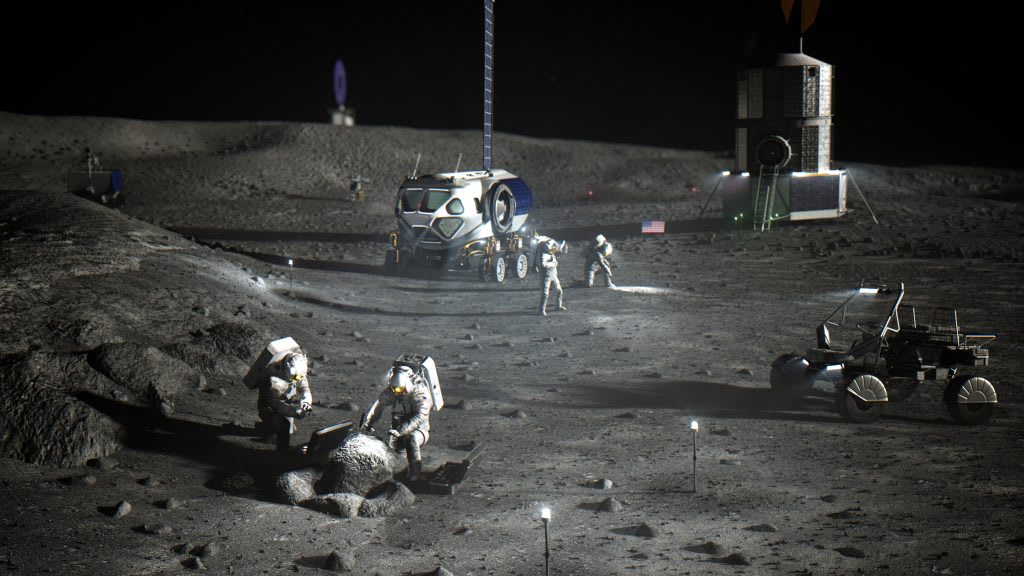Lunar Habitats and Infrastructure
Building the Foundation for Sustainable Moon Settlement

As the possibility of establishing sustainable habitats on the moon becomes a reality, the engineering and technological challenges involved in creating suitable lunar infrastructure are at the forefront. From designing habitats to utilizing local resources, innovative concepts such as 3D printing, inflatable structures, and resource utilization hold the key to long-term lunar settlements and facilitating human activities on the moon. Let's explore these concepts and how they can contribute to the development of sustainable habitats on our celestial neighbor.
One of the most promising technologies for lunar habitat construction is 3D printing. The ability to use lunar regolith, the loose soil found on the moon's surface, as a building material has the potential to revolutionize construction methods. NASA and other space agencies have been experimenting with 3D printing techniques, where lunar regolith is mixed with binders to create a durable material that can be used for building structures. This approach not only reduces the need for transporting construction materials from Earth but also takes advantage of the abundant resources available on the moon. 3D printing enables the creation of intricate structures with reduced waste and lower construction times, making it an ideal solution for lunar habitats.
Inflatable structures have also emerged as a viable option for lunar habitats. These structures are lightweight and compact during transportation, but once inflated, they provide a spacious living and working environment. Inflatable habitats can be designed to withstand the harsh lunar conditions, including temperature extremes and micrometeoroid impacts. Additionally, their flexibility allows for easy expansion and reconfiguration as the needs of the lunar settlement evolve over time. Companies like Bigelow Aerospace have been pioneering inflatable habitat designs and conducting tests to validate their suitability for lunar environments.
Utilizing local resources for construction is a fundamental aspect of sustainable lunar habitats. The moon offers a wealth of resources, including lunar regolith, which can be processed to extract useful materials. For instance, the extraction of water ice from permanently shadowed regions can provide a valuable resource for life support systems, fuel production, and even radiation shielding. By utilizing these local resources, the reliance on Earth for resupply missions can be significantly reduced, making lunar settlements more self-sustaining and economically viable.
Another critical consideration for lunar habitats is radiation protection. The moon lacks a protective atmosphere and magnetic field, exposing lunar settlers to higher levels of radiation compared to Earth. To mitigate this risk, habitats can be designed with built-in shielding materials or strategically placed underground to take advantage of the lunar soil's natural shielding properties. Additionally, innovative materials and technologies can be employed to create radiation-resistant structures that ensure the safety and well-being of the lunar inhabitants.
Furthermore, the development of sustainable lunar infrastructure extends beyond habitats. It encompasses power generation, waste management, communication networks, and transportation systems. The moon's proximity to the sun provides an abundance of solar energy, which can be harnessed using solar panels to meet the power requirements of the lunar settlement. Waste management systems need to be designed to minimize environmental impact and promote recycling and reusing of resources. Robust communication networks are crucial for maintaining connectivity with Earth and facilitating communication among lunar settlers. Additionally, transportation systems, such as rovers or even lunar railways, can be developed to enable efficient movement across the lunar surface.
The establishment of sustainable habitats on the moon is not only a technological challenge but also a collaborative effort involving various stakeholders, including space agencies, private companies, and international partners. Cooperation and knowledge-sharing are essential for driving innovation, addressing common challenges, and ensuring the long-term success of lunar settlements.
In conclusion, the engineering and technological challenges associated with creating sustainable habitats on the moon are being met with groundbreaking concepts and innovative solutions. By leveraging technologies like 3D printing, inflatable structures, and resource utilization, we can build durable and efficient lunar habitats that support long-term settlements and facilitate human activities on the moon. These advancements bring us closer to a future where the moon becomes a thriving hub of scientific research, resource utilization, and potentially even a stepping stone for further space exploration.
About the Creator
Enjoyed the story? Support the Creator.
Subscribe for free to receive all their stories in your feed. You could also pledge your support or give them a one-off tip, letting them know you appreciate their work.





Comments
There are no comments for this story
Be the first to respond and start the conversation.